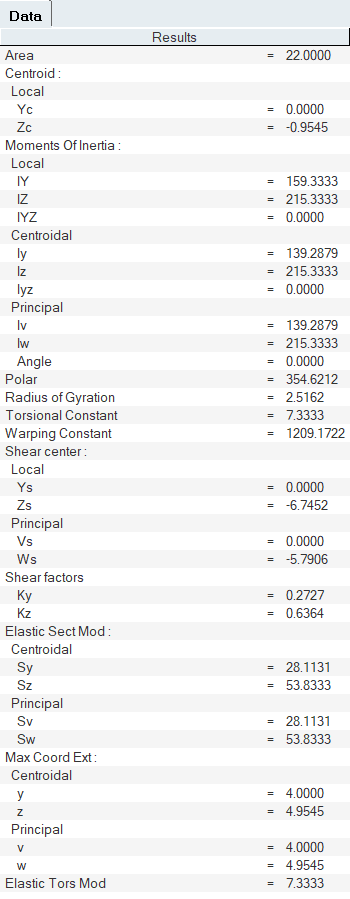HyperBeam Results Pane
Whenever HyperBeam computes the section properties of the current section, it displays them in the Results pane.

Figure 1.
View new features for HyperWorks 2022.3.
Learn the basics and discover the workspace.
Discover HyperWorks functionality with interactive tutorials.
Start HyperWorks and configure the applications.
View a list of deprecated HyperWorks panels and their newer, equivalent workflows.
Create, open, import, and save models.
Set up sessions and create report templates.
Solver interfaces supported in HyperWorks.
A solver interface is made up of a template and a FE-input reader.
Browsers supply a great deal of view-related functionality by listing the parts of a model in a tabular and/or tree-based format, and providing controls inside the table that allow you to alter the display of model parts.
Create and edit 2D parametric sketch geometry.
Create, edit, and cleanup geometry.
FE geometry is topology on top of mesh, meaning CAD and mesh exist as a single entity. The purpose of FE geometry is to add vertices, edges, surfaces, and solids on FE models which have no CAD geometry.
Different types of mesh you can create in HyperWorks.
Define meshing preferences.
Edit the Parameter and Criteria files and define mesh controls using the Mesh Controls Browser.
1D mesh that allows accurate testing of connectors, such as bolts, and similar rod-like or bar-like objects that can be modeled as a simple line for FEA purposes.
Create and edit beam sections of different configurations.
Use the Section Property tools to create Shell, Solid, or Elastic sections from model entities.
Parts are created from inputs. Solid parts are generated for each island of surfaces while Shell parts are created for line regions whenever the thickness changes as well as at t-junctions.
Use the Section Property tools to update properties assigned to bar2 elements (target) using a cross section on various entities as the source.
The Section Browser presents a hierarchical view of all of the beamsections and beamsection collectors in your database.
Access additional tools from the HyperBeam View toolbar.
The graphics area displays a representation of the geometric layout of the section.
Whenever HyperBeam computes the section properties of the current section, it displays them in the Results pane.
Types of HyperBeam sections that can be defined.
The beam cross section is always defined in a y,z plane.
Overview of how to import and export HyperBeam comments.
Use the Member Mesh tool to create 1D elements on edges, free lines, nodes, or members.
Use Stiffener Mesh tool to create 1D elements as shell stiffeners from orphan lines representing trailing edges.
Align, orient, and offset 1D elements, and release degrees of freedom.
Use the Review tool to plot area moments of inertia and stiffness.
Use the Inflate tool to create 2D shell mesh or 3D solids from 1D beams.
These tools enable the creation of 1D elements from surface lines, organizing them into components. They also offset/orient these elements based on the attached shell elements and calculating properties of these 1D elements from 3D solid or shell FE element sections.
A surface mesh or "shell mesh" represents model parts that are relatively two-dimensional, such as sheet metal or a hollow plastic cowl or case.
Volume mesh or "solid meshing" uses three-dimensional elements to represent fully 3D objects, such as solid parts or sheets of material that have enough thickness and surface variety that solid meshing makes more sense than 2D shell meshing.
Create and edit 0D, 1D, 2D, and 3D elements.
Create, organize and manage parts and subsystems.
HyperMesh composites modeling.
Create connections between parts of your model.
Rapidly change the shape of the FE mesh without severely sacrificing the mesh quality.
Create a reduced ordered model to facilitate optimization at the concept phase.
Workflow to support topology optimization model build and setup.
Setup an Optimization in HyperWorks.
Multi-disciplinary design exploration and optimization tools.
Validate the model built before running solver analysis.
Models require loads and boundary conditions in order to represent the various physics and/or physical equivalents to bench and in-use testing.
Reduce a full 3D model with axisymmetric surfaces while accounting for imperfections.
Tools and workflows that are dedicated to rapidly creating new parts for specific use cases, or amending existing parts. The current capabilities are focused on stiffening parts.
Tools used for crash and safety analysis.
Airbag solutions offer airbag folder utilities and exports a resulting airbag in a Radioss deck.
Essential utility tools developed using HyperWorks-Tcl.
Import an aeroelastic finite element model with Nastran Bulk Data format.
Framework to plug certification methods to assess margin of safety from the model and result information.
Create evaluation lines, evaluate them, and optimize the interfaces to eliminate squeak and rattle issues.
Panels contains pre-processing and post-processing tools.
Results data can be post-processed using both HyperMesh and HyperView.
HyperGraph is a data analysis and plotting tool with interfaces to many file formats.
MotionView is a general pre-processor for Multibody Dynamics.
MediaView plays video files, displays static images, tracks objects, and measures distances.
TableView creates an Excel-like spreadsheet in HyperWorks.
TextView math scripts reference vector data from HyperGraph windows to automate data processing and data summary.
Create, define, and export reports.
Different types of mesh you can create in HyperWorks.
1D mesh that allows accurate testing of connectors, such as bolts, and similar rod-like or bar-like objects that can be modeled as a simple line for FEA purposes.
Whenever HyperBeam computes the section properties of the current section, it displays them in the Results pane.
Whenever HyperBeam computes the section properties of the current section, it displays them in the Results pane.

© 2023 Altair Engineering, Inc. All Rights Reserved.
Intellectual Property Rights Notice | Technical Support | Cookie Consent